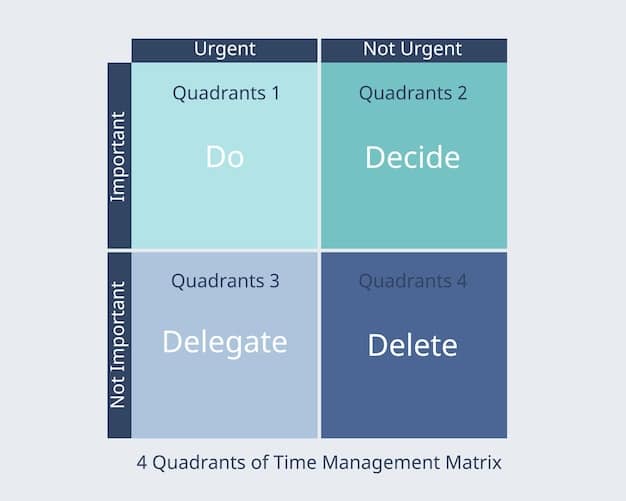Eisenhower Matrix: Master Task Prioritization & Boost Productivity

The Eisenhower Matrix, also known as the Urgent-Important Matrix, is a powerful productivity tool that helps you prioritize tasks by categorizing them into four quadrants: urgent and important, important but not urgent, urgent but not important, and neither urgent nor important.
Feeling overwhelmed by your to-do list? The Eisenhower Matrix: Prioritize Tasks and Eliminate Time Wasters in the Current Work Environment offers a strategic approach, inspired by President Dwight D. Eisenhower, to effectively manage your time and focus on what truly matters.
Understanding the Eisenhower Matrix
The Eisenhower Matrix, also referred to as the Urgent-Important Matrix, is a time management tool that helps you prioritize tasks by categorizing them into four quadrants. This allows you to focus on activities that provide the most value and eliminate those that waste your time.
This powerful technique offers a framework for evaluating tasks based on their urgency and importance. By strategically categorizing your workload, you can effectively allocate your time and energy toward the activities that genuinely contribute to your goals, while minimizing distractions and time-wasting activities.
The Origins of the Eisenhower Matrix
Dwight D. Eisenhower, the 34th President of the United States, was renowned for his productivity and decision-making abilities. He once said, “What is important is seldom urgent and what is urgent is seldom important.” This quote encapsulates the core principle behind the Eisenhower Matrix, which categorizes tasks based on their urgency and importance.
The Four Quadrants Explained
The Eisenhower Matrix uses four quadrants to categorize tasks:
- Quadrant 1: Urgent and Important: These are tasks that require immediate attention and contribute significantly to your goals. Examples include crises, deadlines, and pressing problems.
- Quadrant 2: Important but Not Urgent: These tasks are important for long-term success but don’t require immediate action. Examples include planning, relationship building, and preventative maintenance.
- Quadrant 3: Urgent but Not Important: These tasks demand immediate attention but don’t contribute significantly to your goals. Examples include interruptions, some meetings, and certain phone calls.
- Quadrant 4: Neither Urgent nor Important: These tasks are time-wasters that should be eliminated. Examples include social media scrolling, excessive browsing, and trivial activities.
By understanding the four quadrants, you can begin to prioritize your tasks effectively, focusing on what will make the most difference in the long run.
In essence, the Eisenhower Matrix enables you to strategically allocate your time and attention, ensuring that you are not merely reacting to the urgent demands of the moment but also proactively working towards your long-term objectives.
Implementing the Eisenhower Matrix in Your Workflow
Integrating the Eisenhower Matrix into your daily routine can significantly improve your productivity and reduce stress. Several techniques can help you implement this matrix effectively, transforming the way you approach task management.
To get the most out of the Eisenhower Matrix, it’s important to learn practical strategies for applying its principles to your day-to-day responsibilities.

Step-by-Step Guide to Using the Matrix
Here’s a simple guide to integrate the Eisenhower Matrix into your workflow:
- List All Your Tasks: Begin by creating a comprehensive list of all your tasks, both professional and personal.
- Categorize Each Task: Evaluate each task and assign it to one of the four quadrants based on its urgency and importance.
- Prioritize Your Actions: Focus on Quadrant 1 tasks first, then Quadrant 2. Delegate or minimize Quadrant 3 tasks, and eliminate Quadrant 4 tasks.
- Review and Adjust: Regularly review your matrix to ensure tasks are correctly categorized and adjust your priorities as needed.
Tools and Templates to Help You
Various tools and templates can help you implement the Eisenhower Matrix. These include:
- Digital Templates: Online templates and apps that allow you to create and manage your matrix digitally.
- Whiteboards: A physical whiteboard where you can visually map out your tasks into the four quadrants.
- Spreadsheets: Basic spreadsheets can be customized to create a simple yet effective Eisenhower Matrix.
By utilizing these tools, you can streamline the process of categorizing and prioritizing your tasks, making the Eisenhower Matrix an indispensable part of your productivity toolkit.
By carefully and thoughtfully applying the Eisenhower Matrix, you can quickly distinguish between tasks that need your immediate attention and those that can be scheduled for later, delegated to someone else, or eliminated altogether.
The Benefits of Prioritizing with the Eisenhower Matrix
The Eisenhower Matrix offers numerous advantages for enhancing productivity and managing time effectively. Using this prioritization tool will bring about meaningful changes in your professional and personal life.
These benefits can lead to reduced stress, better decision-making, and a more balanced approach to handling responsibilities, making it a valuable asset for anyone looking to boost their efficiency.
Reduced Stress and Overwhelm
By categorizing tasks and focusing on the most important ones, the Eisenhower Matrix can significantly reduce feelings of stress and overwhelm. This is achieved through:
- Clear Prioritization: Knowing exactly what needs to be done and when helps alleviate anxiety.
- Focus on Important Tasks: Concentrating on high-value activities reduces stress associated with trivial tasks.
- Controlled Workload: Eliminating or delegating tasks frees up time and mental space, leading to a calmer approach.
Improved Decision-Making
The matrix can improve your decision-making abilities by providing a structured way to evaluate choices. This results in:
- Strategic Resource Allocation: Decisions about where to invest your time and energy become clearer when using the matrix.
- Better Focus: By eliminating distractions, you can concentrate on making informed decisions.
- Proactive Planning: The matrix encourages planning and foresight, improving the quality of your decisions.
By thoughtfully organizing your tasks within the Eisenhower Matrix, you effectively minimize distractions and enhance your focus, which enables you to make well-informed decisions that align with your objectives.
The ability to effectively prioritize your tasks not only reduces stress but also empowers you to proactively manage your workload, leading to a more organized and efficient approach to your daily responsibilities.
Addressing Common Challenges with the Matrix
While the Eisenhower Matrix is a powerful tool, some common challenges can arise when implementing it. Identifying and addressing these challenges is crucial for maximizing the matrix’s effectiveness.
Being aware of these common pitfalls and understanding how to navigate them ensures that you can consistently leverage the Eisenhower Matrix to enhance your productivity.

Difficulty in Accurately Categorizing Tasks
One common challenge is accurately categorizing tasks. This can be addressed by:
- Defining Clear Criteria: Establish specific criteria for what constitutes “urgent” and “important” in your context.
- Seeking Feedback: Consult with colleagues or mentors to get an external perspective on task prioritization.
- Regular Review: Re-evaluate your matrix regularly to ensure tasks are still appropriately categorized based on changing circumstances.
Overestimation of Urgency
Another challenge is overestimating the urgency of certain tasks. To combat this, consider:
- Assessing Impact: Evaluate the potential consequences of delaying a task to determine its true urgency.
- Practicing Mindfulness: Take a moment to pause and reflect before automatically assigning tasks to the “urgent” category.
- Time Blocking: Schedule specific times for both urgent and important tasks to manage your time effectively.
Dealing with Unexpected Tasks
Another frequent issue is how to incorporate unexpected tasks into the matrix:
- Immediate Assessment: Evaluate new tasks immediately to determine their urgency and importance.
- Matrix Integration: Fit the new task into the existing matrix, re-prioritizing if necessary.
- Flexibility: Be prepared to adjust your schedule and priorities to accommodate unforeseen responsibilities.
By recognizing and proactively addressing these challenges, you can ensure that the Eisenhower Matrix remains a reliable tool for enhancing productivity and managing your workload efficiently.
By taking a thoughtful approach and establishing clear criteria for task categorization, you can mitigate the risk of misclassifying tasks and optimize the overall effectiveness of the Eisenhower Matrix.
Advanced Strategies for Eisenhower Matrix Users
For those who have mastered the basics of the Eisenhower Matrix, several advanced strategies can further enhance its effectiveness. These techniques can fine-tune your approach and empower you to make even more impactful decisions about your time and priorities.
These advanced techniques ensure that the Eisenhower Matrix remains a dynamic and adaptive tool that continues to support your evolving goals and responsibilities.
Integrating with Other Productivity Systems
Enhance the Eisenhower Matrix by integrating it with other productivity systems, such as:
- GTD (Getting Things Done): Use GTD to capture and organize tasks, then use the Eisenhower Matrix to prioritize them.
- Pomodoro Technique: Focus on high-priority Eisenhower Matrix tasks using the Pomodoro Technique for concentrated work.
- Time Blocking: Allocate specific time blocks for tasks in each quadrant of the matrix for better time management.
Leveraging Technology
Technology can play a crucial role in optimizing the Eisenhower Matrix. Consider using:
- Task Management Apps: Apps like Todoist, Trello, or Asana to manage and categorize tasks within the matrix.
- Calendar Integrations: Sync your task management app with your calendar to schedule and track tasks effectively.
- Automation Tools: Use tools like Zapier to automate repetitive tasks and free up time for higher-priority activities.
These applications ensure that the Eisenhower Matrix remains a dynamic and adaptive tool that supports your evolving goals and responsibilities.
Moreover, regularly reassess and update your tasks and priorities, as well as adjust the criteria for urgency and importance to remain effective.
Real-World Examples of Eisenhower Matrix Success
The effectiveness of the Eisenhower Matrix is best illustrated through real-world examples where individuals and organizations have successfully implemented it to achieve strategic goals.
These case studies highlight the versatility and practical benefits of the matrix, inspiring others to adopt this powerful prioritization tool in their own lives and businesses.
Case Study 1: Small Business Owner
A small business owner struggled to manage multiple roles and responsibilities. By implementing the Eisenhower Matrix:
- Quadrant 1 (Urgent & Important): Addressed immediate customer issues and critical financial deadlines.
- Quadrant 2 (Important & Not Urgent): Focused on strategic planning, marketing, and employee development.
- Quadrant 3 (Urgent & Not Important): Delegated administrative tasks and non-essential meetings.
- Quadrant 4 (Neither Urgent nor Important): Eliminated time-wasting activities such as excessive social media browsing.
As a result, the business owner experienced reduced stress, improved productivity, and significant business growth.
Case Study 2: Project Management Team
A project management team used the Eisenhower Matrix to streamline their workflow:
- Quadrant 1: Resolved critical project milestones and pressing client requests.
- Quadrant 2: Focused on project planning, risk assessment, and team coordination.
- Quadrant 3: Delegated routine tasks and unnecessary meetings.
- Quadrant 4: Eliminated unproductive activities like prolonged coffee breaks and idle chat.
This resulted in projects being completed on time, within budget, and with increased team satisfaction.
These real-world case studies demonstrate the practicality of the Eisenhower Matrix across various industries and professions, showcasing its significant impact on enhancing productivity and success.
The matrix not only enhances productivity but also ensures that you proactively manage your workload, focus on tasks that bring the most value, and create a more efficient and effective approach to achieving your goals.
| Key Point | Brief Description |
|---|---|
| ✅ Quadrant Definitions | Urgent/Important, Important/Not Urgent, Urgent/Not Important, Neither. |
| 🚀 Implementation Steps | List tasks, categorize quadrants, prioritize, and review regularly. |
| 🎯 Benefits | Reduced stress, better decisions, strategic resource allocation. |
| ⚙️ Overcoming Challenges | Assess new tasks, define clear criteria, and seek external feedback. |
Frequently Asked Questions (FAQs)
▼
The main principle is to differentiate between tasks that are urgent and those that are important, helping you to focus on high-value activities.
▼
You should review it regularly, ideally daily or weekly, to ensure tasks are correctly categorized and priorities are aligned with your current goals.
▼
Yes, the Eisenhower Matrix is versatile and can be applied to both personal and professional tasks for effective time management.
▼
Tasks in this quadrant are generally time-wasters and should be eliminated to free up time and mental space for more valuable activities.
▼
Yes, a task can move between quadrants as its urgency or importance changes due to evolving circumstances or deadlines.
Conclusion
The Eisenhower Matrix provides a robust framework for enhancing productivity and effective time management. By strategically organizing your tasks based on urgency and importance, you can free up time for higher-value activities, reduce stress, and achieve your goals with greater clarity and focus.





